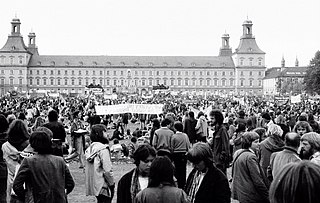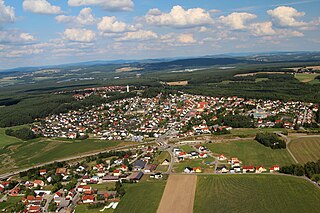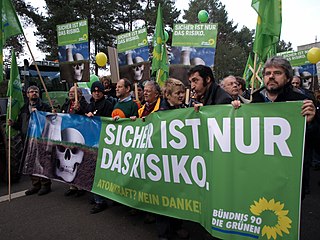Related Research Articles

Zwentendorf an der Donau is a small market municipality in the Austrian state of Lower Austria. It is located at 48°21′N15°54′E, in the Tulln Basin on the southern bank of the Danube. The place attained public attention as the site of the only Austrian nuclear power station, which was completed but never went into operation. In a referendum on 5 November 1978, a narrow majority of 50.5% voted against putting the Zwentendorf nuclear plant into operation.
A nuclear-free zone is an area in which nuclear weapons and nuclear power plants are banned. The specific ramifications of these depend on the locale in question.

A nuclear power phase-out is the discontinuation of usage of nuclear power for energy production. Often initiated because of concerns about nuclear power, phase-outs usually include shutting down nuclear power plants and looking towards fossil fuels and renewable energy. Three nuclear accidents have influenced the discontinuation of nuclear power: the 1979 Three Mile Island partial nuclear meltdown in the United States, the 1986 Chernobyl disaster in the USSR, and the 2011 Fukushima nuclear disaster in Japan.

The anti-nuclear movement is a social movement that opposes various nuclear technologies. Some direct action groups, environmental movements, and professional organisations have identified themselves with the movement at the local, national, or international level. Major anti-nuclear groups include Campaign for Nuclear Disarmament, Friends of the Earth, Greenpeace, International Physicians for the Prevention of Nuclear War, Peace Action, Seneca Women's Encampment for a Future of Peace and Justice and the Nuclear Information and Resource Service. The initial objective of the movement was nuclear disarmament, though since the late 1960s opposition has included the use of nuclear power. Many anti-nuclear groups oppose both nuclear power and nuclear weapons. The formation of green parties in the 1970s and 1980s was often a direct result of anti-nuclear politics.

Wyhl is a municipality in the district of Emmendingen in Baden-Württemberg in southwestern Germany.

Burglengenfeld is a town in the district of Schwandorf, in Bavaria, Germany. It is situated on the river Naab, 22 km north of Regensburg.
The Anti-WAAhnsinns Festival was a series of political rock concerts which took place in Germany during the 1980s. Its purpose was to support protests against the planned nuclear reprocessing plant Wackersdorf in Wackersdorf. In 1986, the fifth festival marked the peak of the protest movement against the plant. With over 100,000 people attending on 26 and 27 July, it was the largest rock concert in the history of Germany. The line-up included some of Germany's most popular music acts of the time such as BAP, Die Toten Hosen, Udo Lindenberg, Rio Reiser, Herbert Grönemeyer. The festival remained completely peaceful, contrary to government expectations. As a result of the overwhelming protests, the festivals resulted in unexpected media coverage for the anti-nuclear movement in Germany.

Wackersdorf is a municipality in the district of Schwandorf in Bavaria, Germany. It is famous for playing host to rounds of the CIK-FIA Karting European Championship.
Klaus Traube was a German engineer and former manager in the German nuclear power industry and one of its leading opponents. He was the victim of an illegal eavesdropping operation by the BfV, because he was falsely suspected of passing on secret information to people sympathizing with terrorism, notably the Red Army Faction.

Krümmel Nuclear Power Plant is a German nuclear power plant in Geesthacht, Schleswig-Holstein, near Hamburg. It was taken into operation in 1983 and is owned 50% by Vattenfall via Vattenfall Europe Nuclear Energy GmbH and 50% by E.ON, and operated by the Swedish Vattenfall. Its gross power production is 1,401 MW, using a boiling water reactor.

The Brunsbüttel Nuclear Power Plant is a nuclear power plant in Brunsbüttel near Hamburg, Germany. It is owned 67% by Vattenfall and 33% by E.ON. It started operation in 1976 and has a gross power production of 806 MW. During its lifetime, it produced 130,000 GW hours of electricity. The value of this electricity is about 9.1 billion Euros before calculation of the nuclear waste management.

The anti-nuclear movement in Germany has a long history dating back to the early 1970s when large demonstrations prevented the construction of a nuclear plant at Wyhl. The Wyhl protests were an example of a local community challenging the nuclear industry through a strategy of direct action and civil disobedience. Police were accused of using unnecessarily violent means. Anti-nuclear success at Wyhl inspired nuclear opposition throughout Germany, in other parts of Europe, and in North America. A few years later protests raised against the NATO Double-Track Decision in Germany and were followed by the foundation of the Green party.

Freda Meissner-Blau was an Austrian politician, activist, and prominent figurehead in the Austrian environmental movement. She was a founder and the federal spokesperson of the Austrian Green Party.
Armin Weiss was a German inorganic chemist and politician of the Green Party.
Construction of the first Austrian nuclear power plant in Zwentendorf on the Danube, about 30 kilometres upstream from the capital, Vienna, began in 1972. Zwentendorf Nuclear Power Plant was designed as a boiling water reactor with a capacity of 700 MW(e), that was expected to generate about 10% of the Austrian electricity production.

The Zwentendorf Nuclear Power Plant was the first commercial nuclear plant for electric power generation built in Austria, of 3 nuclear plants originally envisioned. Construction of the plant at Zwentendorf, Austria was finished but the plant never entered service. The start-up of the Zwentendorf plant, as well as the construction of the other 2 plants, was prevented by a referendum on 5 November 1978, in which a narrow majority of 50.47% voted against the start-up.
Since 1998 the Nuclear-Free Future Award (NFFA) is an award given to anti-nuclear activists, organizations and communities. The award is intended to promote opposition to uranium mining, nuclear weapons and nuclear power.

In the 1960s the Austrian government started a nuclear energy program and parliament unanimously ordered a nuclear power plant built. In 1972, the German company KWU began construction of the Zwentendorf Nuclear Power Plant boiling water 700 MWe reactor. In 1976, two years prior to the nuclear power plant opening, the government began a program to educate its citizens on the benefits and safety of nuclear power. However, this campaign began a public discussion that led to large demonstrations against the Zwentendorf plant in 1977.

The Wackersdorf nuclear reprocessing plant is a reprocessing plant in Wackersdorf in Bavaria, Germany. Because of protests the plant was never completed. Today it is an industrial site with no special features.
References
- ↑ "2004 Nuclear-Free Future Lifetime Award". Archived from the original on 2007-10-24. Retrieved 2007-12-18.